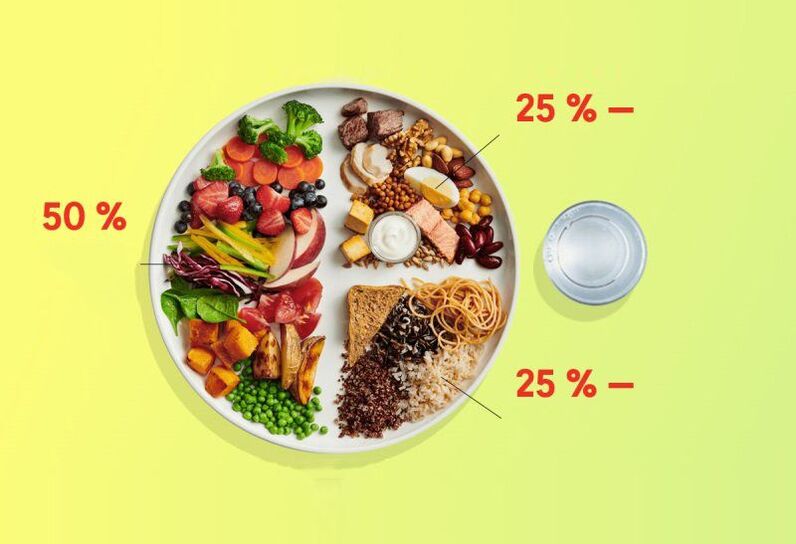
There are very few people who are satisfied with their reflection in the mirror. The diet helps improve your appearance and health. Literally from Greek, diet is translated as diet, a way of life.
Many diets have been developed to maintain beauty and health. However, it is best for you to create your own menu for a week of reasonable nutrition to lose weight.
Sample menus with recipes will help you navigate in the choice of products, organization of the diet and mode of food consumption.
Proper nutrition for weight loss: general rules
One gains weight gradually, one should also get rid of it methodically. When losing weight, the body experiences stress. To reduce negativity, it is necessary to have a reasonable diet.
- Comply with the regime. Food is taken at certain times with a gap of 3-4 hours between meals.
- Drink more liquids. Water speeds up metabolism, eliminates toxins and promotes food absorption.
- Eat a varied diet. The diet includes foods that contain proteins, carbohydrates, lipids, vitamins and minerals.
- Balancing diet. When compiling the menu, the ratio of BJU is observed. Increase consumption of fresh vegetables and fruits. Plant foods are rich in vitamins and fiber, helping to purify the body without losing important trace elements.
- Count calories. To lose weight without harm, the recommended daily calorie intake for women is 1300, for men it is 1600.
- Reduce consumption of animal fats and fast carbohydrates. Overuse of these nutrients increases the risk of obesity and endocrine diseases.
- Refuse alcohol. Alcohol destroys physical and mental health.
Eating healthy: list of foods to help lose weight
A healthy diet includes only healthy foods. Don't focus on the vitamins contained in vegetables and fruits. The menu should contain all the nutrients necessary for normal life.
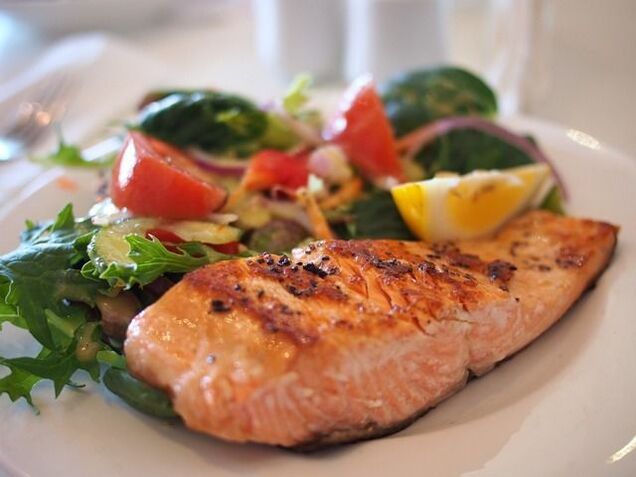
Exact product list:
- water, consume about 1. 5 liters per day + liquid dishes (soups);
- meat: poultry, beef, veal;
- fish: seabass, haddock, salmon;
- seafood: squid, mussels;
- quail eggs and chicken eggs;
- cereals: buckwheat, bulgur, rice;
- pea's tree;
- dairy products supplemented with lactic acid bacteria: fermented baked milk, yogurt, kefir;
- Garden crops, root crops;
- fruit of trees and bushes;
- green trees;
- Limited nuts and seeds.
The list is very extensive, you can cook many different dishes. The daily diet includes both plant and animal foods and vitamins.
For greater benefits, try to consume seasonal vegetables and fruits.
Plan a healthy meal menu
Reviewing your diet means making changes to your lifestyle, and they require you to create a plan that you will stick to going forward.
- Daily mode. It's been a long time since people have woken up and gone to sleep under the sun. The ratio of men and women working at night is quite high. There are also "owls" and "larks". These elements are fundamental in the breakfast and dinner schedule.
- Diet. Before creating a suitable nutritional menu, you need to decide on your goals. There is one diet to regulate weight and another diet to maintain health. If you need to lose more than 5 kg, the menu is limited but not sudden.
- Intuitive planning. The diet is planned for the week by the hour. It is more convenient to enter data into the table. This will allow you to monitor quality and quantity. The easiest way is to download a special application.
- Smooth transition. The changes were implemented smoothly. Sudden calorie restriction often has the opposite result. When lacking nutrients, the body will store it as fat. During the first week, it is enough to eliminate harmful foods.
Weekly menu for men: features
Most men play sports or go to the gym. Increased load and anatomical features affect the diet.

Physical activity level is the first thing to consider when planning a weekly menu for men.
The comprehensive menu can include many different products, but the diet must meet the following requirements:
- Hearty breakfast. Energy consumption in men is on average 1/3 more than in women. Breakfast "starts" the body. A man's breakfast should be complete. Contains animal proteins, moly- and monosaccharides, lipids. The latter provides energy.
- Dinner is serious business. Eat dinner 2 hours before going to bed. Product set and calorie content depend on several factors. During intensive training in the evening, you should replenish spent resources - eat proteins and carbohydrates (mainly disaccharides and polysaccharides) in the correct proportions.
- Strictly calculate your protein intake. Protein is the building material of tissues. The stronger sex should consume it in larger quantities than women. But excess protein will lead to increased uric acid formation and lead to kidney and joint diseases.
- Fat. Lipids play an important role in steroid formation. The daily norm for men is 25-30% of the total amount of nutrients consumed. Furthermore, the consumption of vegetable fats is minimized. They contain α-linoleic acid, which increases the risk of developing prostate tumors.
- Vitamins and minerals. Zinc and iodine are important for men's health.
Approximate menu for losing weight in a week with 1500 kcal
Organizing proper nutrition for a week to lose weight includes choosing foods based on their calorie content. A daily intake of 1500 kcal is suitable for men who want to lose weight or women who want to stay in shape. The diet is not strict, suitable for long-term use. If you calculate calories correctly, you can lose up to 3 kg in 7 days.
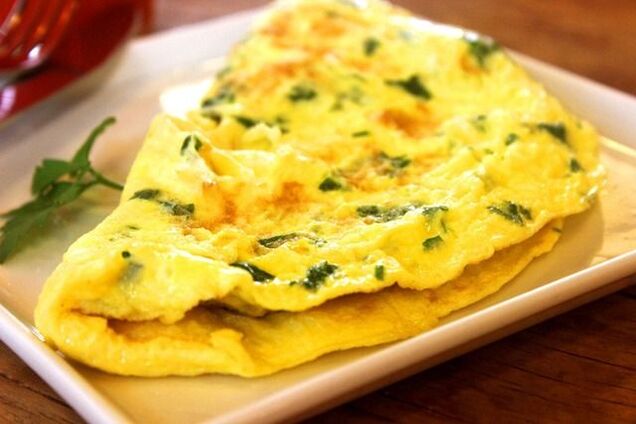
You should start eating right not on Monday but from tomorrow!
Sample diet for one week:
| day | breakfast | dinner | dinner |
| I | omelets, porridge | soup, grilled brisket | Steamed potatoes with salmon, kefir |
| II | oatmeal, cheese, coffee | mushroom soup, buckwheat, bread | cheese, yogurt |
| III | cheese, yogurt, muesli | Grilled salmon with pepper | asparagus with herbs, fermented grilled milk |
| IV | seaweed salad, tea | Pickles, spaghetti | Boiled brisket, lettuce, juice |
| V. | boiled eggs, buckwheat | Grilled cod with dried fruit, rice | cheese, apples |
| BECAUSE | oatmeal, milk tea | Stew eggplant and tomatoes | yogurt, pineapple |
| VII | cheese, orange | Bean soup, boiled turkey | vinegar oil, fruit juice |
Diet menu for the week (table) with recipes
Dietary nutrition includes limited consumption of animal products. To accelerate weight loss, reduce daily calorie intake by 100 kcal. You can accurately calculate the energy value using an online calculator.
| days of week | breakfast | dinner | dinner |
| Monday | apples, 2 loaves of bread | Pureed vegetable soup, steamed potatoes | ham, grapefruit |
| Tuesday | yogurt, cheese, tea | Lean radish soup, boiled rice | steamed fish, vegetable juice |
| Wednesday | muesli, banana | barley porridge, boiled veal | Fresh vegetable salad, tea |
| Thursday | yogurt, low-fat hard cheese | Vegetable soup, apple | steamed cauliflower |
| Friday | corn flakes, juice | French fries, bread | kefir, strawberries |
| Saturday | Omelette with herbs and chicory | Tilapia cutlets, cucumbers, chili | Ryazhenka, oatmeal cookies |
| Sunday | stewed vegetables, tea | Sorrel soup, turkey meatballs | cheese, cucumber |
Dietary meals are prepared simply and quickly. Potato cutlets will appeal to all family members.
A reasonable nutritional menu helps lose weight in a week
When planning a healthy nutritional menu for the week, you need to adhere to two main goals: create a calorie deficit for weight loss by eliminating high-calorie foods from your diet and providebody healthy nutrients. The basis of a proper daily diet should be foods rich in protein (meat, fish, cheese), which stimulate metabolism and are a valuable source of essential amino acids.
It is also recommended to consume only complex carbohydrates (whole grains and non-starchy vegetables) to provide the body with energy without causing the accumulation of fatty tissue.
It is necessary to exclude simple carbohydrates from the diet menu, which cause a quick feeling of hunger, weight gain and a constant feeling of fatigue.
Priority should be given to saturated fats of plant and animal origin (no more than 30 grams per day), because a lack of fatty acids will slow down metabolism, reduce the production of female sex hormones and lead to irregular menstruation. even. Sources of healthy fats include nuts, sunflower seeds and fatty fish.
Basic rules

- Remove prohibited foods and drinks from the menu.
- Drink the optimal amount of water per day (30 ml per 1 kg of weight).
- Maintain daily calorie intake (from 1200 kcal to 1600 kcal). To calculate the energy value of food, you can use the calorie table.
- The amount of BJU in the daily menu should be 40-45% protein, 15-20% fat and 30-40% carbohydrates.
- Apply the plate rule: half the main serving should be vegetables and a quarter of each serving should be protein (meat, cottage cheese) and carbohydrates (grains).
- Eat fruit before 16: 00 and allow sweets (honey, dried fruit) before 12: 00.
- Avoid overeating, as overeating will lead to increased daily calorie intake and slow down the weight loss process.
- Eat slowly and chew thoroughly to promote proper nutrient absorption.
- Control your salt intake, as excess salt will lead to swelling.
What you can and cannot eat (table)
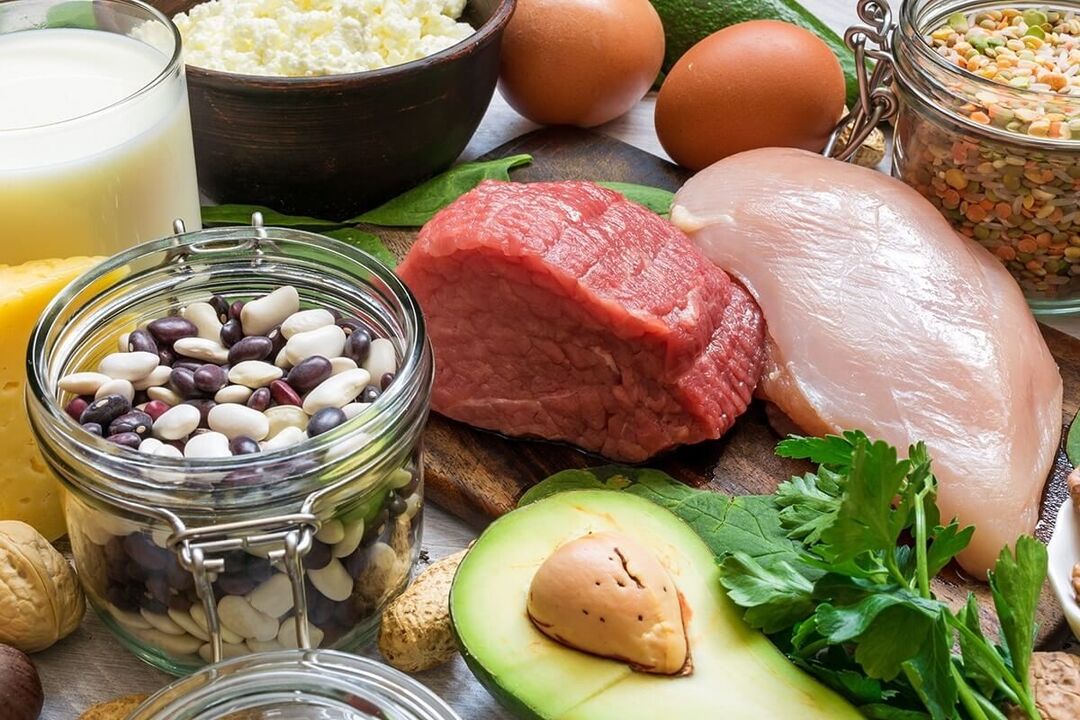
| Wheat flour products | |
| Make cakes from whole wheat, rye, buckwheat, almonds, and unsweetened oatmeal | White bread made from high quality flour, cakes |
| Meat | |
| Lean pork, rabbit, beef | Fatty pork, beef. Sausage |
| Bird | |
| Chicken, turkey | Goose duck |
| Fish and seafood | |
| Cod, cod, chum salmon, pike, pike perch, mullet, pink salmon, tuna, mackerel, herring, salmon, herring, pollock. Seaweed, shrimp, oysters | Salted, smoked fish, canned food, crab sticks |
| Egg | |
| Boiled, in the form of an omelette, as part of a dish | |
| Milk product | |
| Fresh cheese (1-8% fat), kefir, yogurt, low-fat sour cream | Fatty cheese, sour cream, cream. Store-bought yogurt has added additives and glazed cheese |
| Cereal | |
| Green and brown buckwheat, bulgur, pearl barley, Artek cereal, oatmeal, brown rice. Peas, chickpeas, chickpeas, lentils, beans | Instant oats, sugar granola, white rice, semolina |
| Oil | |
| Olive, flaxseed, coconut, sunflower and other vegetable oils. Butter and ghee | Margarine, mayonnaise |
| Vegetable | |
| Cucumbers, tomatoes, carrots, onions, white cabbage, red cabbage, Chinese cabbage, cauliflower, eggplant, avocado, zucchini, bell pepper, spinach, lettuce, spinach, vegetablesparsley, dill. sauerkraut | Conserve. Mashed or fried potatoes |
| fruit | |
| Apples, pears, plums, raspberries, cherries, strawberries, cherries, grapes, mulberries, peaches, oranges, tangerines, grapefruit, apricots, kiwi. Limit: bananas (1 per day), grapes | |
| Dried fruits and nuts | |
| Walnuts, cashews, hazelnuts, nutmeg, pistachios, almonds (no more than 20 g per day). Prunes, dates, figs, apricots, mangoes, dried apricots (no more than 25 g per day) | Peanuts, raisins and dates in bulk |
| Desserts | |
| Honey, date syrup, sweetener, dark chocolate | Confectionery, ice cream, sweets, milk and white chocolate, cookies |
| Drinks | |
| Black, green, mint, chamomile, coffee, chicory, unsweetened barley tea | Wine, sweet carbonated drinks |
How to create a menu
For nutrition to be beneficial and contribute to weight loss, it is important to adhere to the basic rules when drawing up a menu for the week, taking into account the physiological needs of the body:
- consume a daily allowance of protein (1-1. 5 grams per kilogram of weight), distributed throughout the day;
- For breakfast, it is recommended to prepare dishes consisting of proteins and slow carbohydrates for a long feeling of fullness, such as omelets and porridge, oatmeal with curd, etc. v. ;
- Lunch should include proteins, carbohydrates and green vegetables to provide the body with vitamins and fiber;
- The number of meals per day is calculated individually depending on daily habits;
- You should not eat without feeling hungry, because even eating healthy foods without a physiological need will lead to overeating.
Healthy nutritional menu for the week
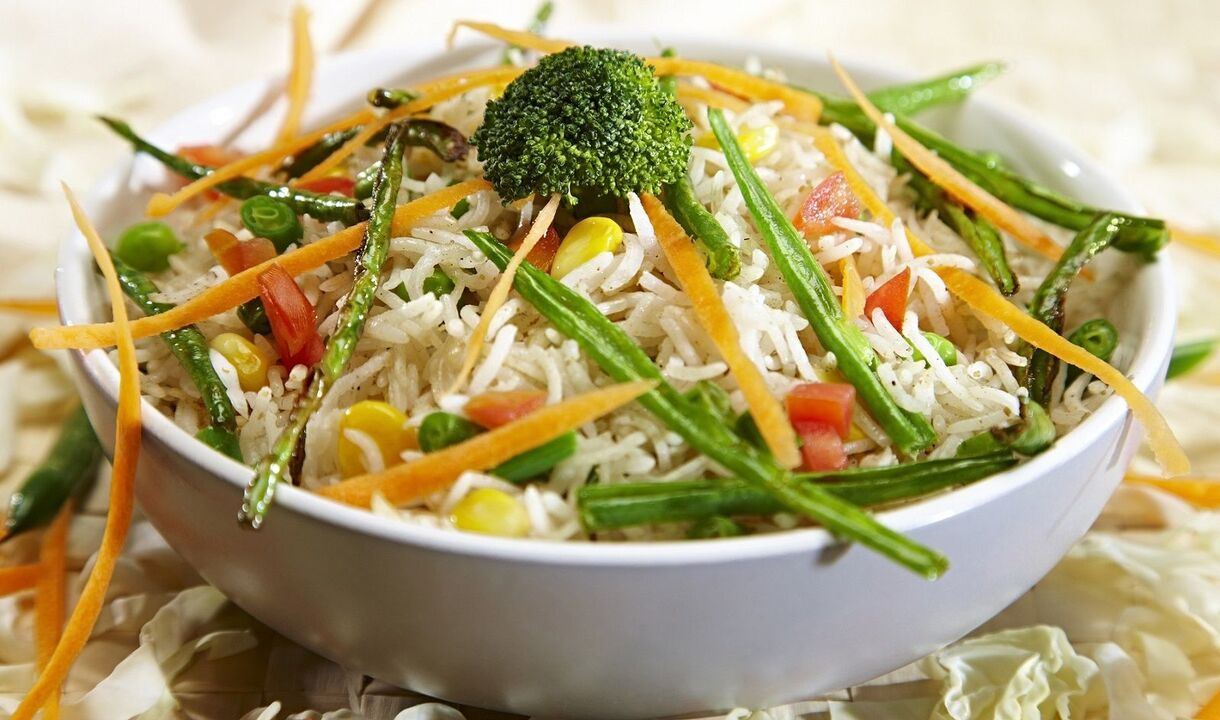
Monday
- Breakfast: whole grain sandwich, boiled eggs, hard cheese, milk coffee;
- Lunch: turkey ribs, stewed meat, vegetables, apples;
- Afternoon snack: cottage cheese with berries;
- Dinner: chicken salad with cucumbers and cabbage.
Tuesday
- Breakfast: cheesecake (with bananas instead of sugar), sour cream, tea or coffee;
- Lunch: tuna salad, banana;
- Afternoon snack: liver pancakes, tomato and cucumber salad;
- Dinner: grilled salmon with broccoli.
Wednesday
- Breakfast: rye bread, butter, cheese, coffee with milk;
- Lunch: grilled turkey fillet, boiled buckwheat, fresh cucumbers, kiwi;
- Afternoon snack: veggie rolls topped with whole-grain pita;
- Dinner: cheese and protein casserole.
Thursday
- Breakfast: whole-grain pancakes, cottage cheese with berries;
- Lunch: chicken fillet, hard pasta, tomato and cheese salad, pear;
- Afternoon snack: baked apples and peaches;
- Dinner: boiled shrimp, lettuce with eggs, onions and lemon juice.
Friday
- Breakfast: 3 fried eggs with tomatoes, green tea;
- Lunch: roasted turkey with zucchini and bell peppers, quinoa, cherries;
- Afternoon snack: banana puree;
- Dinner: salmon and cauliflower cake.
Saturday
- Breakfast: rye bread with cheese and butter, coffee;
- Lunch: boiled shrimp, brown rice, cabbage salad, apple;
- Afternoon snack: cottage cheese with yogurt and nuts;
- Dinner: grilled mushrooms, salad.
Sunday
- Breakfast: oatmeal, cheese with nuts;
- Lunch: steamed chicken cutlets, funchose with vegetables, fruits;
- Afternoon snack: Greek yogurt with berries;
- Dinner: halibut, salad.
Is it possible to lose weight with a proper diet?
At its core, proper nutrition is a balanced diet that allows you to provide your body with the necessary substances. However, despite the fact that the principles of proper nutrition do not impose too strict restrictions, it is very difficult for a person to adjust to their compliance.
Unfortunately, a balanced diet is very rare today. Usually, people overuse unhealthy foods such as fast food, sweets and processed foods, while healthy and delicious foods such as vegetable salad or sea fish appear only occasionally in the diet. single.
By consuming fast carbohydrates, stimulating appetite and changing eating behavior, a person always gains excess weight.
But if you change your eating habits and build your diet according to proper nutritional principles, excess pounds will not accumulate. If you slightly reduce your daily calorie intake, you can reduce your body weight.
To do this, you can replace higher-calorie foods with low-calorie foods, and eliminate nutritious snacks, replacing them with lighter foods. Thanks to that, this diet helps you lose an average of 4 kg per month.
Consequences of malnutrition
Systematic poor nutrition can lead to very serious health problems, which, in turn, have an extremely negative effect on the body.
Excessive body weight gain leads to obesity. Excess weight is not just an aesthetic issue. It causes many diseases: in particular, it causes rapid joint wear, affects the human skeleton and adversely affects the functioning of various systems and organs, causing osteoporosis and atherosclerosis. cardiovascular disease, cardiovascular diseases, etc. v.
Diseases caused by poor nutrition are often associated with deficiencies of minerals and vitamins that are important for the body, which are not provided in sufficient quantities from food. Very often, children and adolescents suffer from vitamin deficiency due to improper diet, which leads to fatigue, reduced performance, irritability, etc. v.
Deterioration in appearance. Tooth enamel deteriorates, acne may appear, hair becomes dull and nail condition also worsens.
Fundamentals of proper nutrition: important tips
Proper nutrition helps maintain health and even restore it. To do this, you need to properly build a healthy diet during the week, making sure the menu includes a variety of healthy foods that can provide the body with minerals and vitamins.
- The menu should include products that meet the need for certain substances. Their deficiency can cause cravings for junk food, as scientists have proven that the desire to eat unhealthy snacks can be related to the lack of certain micronutrients.
- The calorie content of food should be controlled. Maintaining energy balance is important because it determines optimal body weight. The menu should consist mainly of plant-based foods with lots of fiber. These are green vegetables, citrus fruits, apples, peaches, pears, seeds and nuts, and whole grains.
- When creating a menu, you should choose products that are low in sugar and low in fat. The normal amount of sugar per day is up to 50 g, however, ideally you need to further reduce your sugar intake. The amount of fat per day should not exceed 70 g. A healthy menu should completely exclude the presence of trans fats - they are found in products containing hydrogenated vegetable oils.
- The best drinks on a healthy menu are those that contain the fewest calories (green and herbal teas, rose water, etc. ). You should not drink too much juice - the daily dose should not exceed 200 g per day.
- Every day you should consume a certain amount of food from 5 different groups to ensure an ideal balance of nutrients in the body and "supply" enough energy. The first group of products are vegetables and legumes (about 300 g and 70 g per day, respectively). The second is berries and fruits (300 g). The third group is lean meat and fish, eggs, nuts and seeds (one serving of meat or fish, 2 tablespoons of nuts or seeds. The fourth group is grain products that retain maximum fiber (grain productswholegrain cereals, porridge, about 70 g per day) Thursday – low-fat milk and fermented milk products (about 200 g per day).
- It is also important to limit salt intake and foods that are too salty. You should consume no more than 5 g of salt per day.
- Diet is also very important. Therefore, you need to eat breakfast within an hour after waking up and dinner three hours before going to bed. During the day, it is important to offer two nutritious snacks to avoid intense hunger and, therefore, overeating during main meals.
- You should be sure to drink enough fluids every day. Half an hour before meals, drink a glass of warm water.
- Convenience foods may be economical, but that doesn't mean they're healthy. They should be completely abandoned. You should also exclude soda, fast food, hot dogs, snacks, etc. v.
- Eat meals containing carbohydrates in the first half of the day, protein in the second half of the day.
Healthy menu for the week for the family

Age is also important - the menu for people of working age will be different from the diet for children and the elderly.
And if an example of a healthy diet is taken as a basis, then it needs to be diversified so that all family members receive nutritious and sufficient food.
Proper nutrition, menu for the week
Therefore, to eat properly, you need to build a reasonable nutritional menu and try to maintain this habit.
The easiest way is to plan healthy meals for the week for your family or yourself.
When creating such a schedule, it is better to buy food immediately during the week so that you are not initially tempted to buy unhealthy foods. Next, you need to create a weekly meal menu.
An example of proper nutrition for a week may look like this:
Monday
Breakfast: buckwheat porridge with butter (200 g of porridge, 1 spoon of butter), fruit - apple or orange, coffee without sugar.
Snack: bran toast, cucumber salad and a boiled egg with 1 tsp. vegetable oil.
- Lunch: grilled fish – 200 g, green salad (cabbage or green leafy vegetables with olive oil) – 150 g
- Afternoon snack: low-fat cheese – 100 g, dried fruit – 50 g, tea.
- Dinner: stewed vegetables – 200 g, boiled chicken fillet – 150 g.
Tuesday
Breakfast: rye toast and 20 g of hard cheese, banana, coffee without sugar.
Snack: low-fat yogurt, 1 tsp. Honey
- Lunch: vegetable soup or chicken broth - 200 g, salad with cucumbers, tomatoes or cabbage - 200 g.
- Afternoon snack: optional fruit, herbal tea.
- Dinner: boiled lean meat (chicken, rabbit, veal) – 250 g, cucumbers – fresh or pickled.
Wednesday
Breakfast: oatmeal - 150 g, 1 teaspoon. honey, banana, coffee or tea.
- Snack: nuts – 50 g, apple, tea.
- Lunch: pilaf with lean meat – 200 g, stewed vegetables – 150 g.
- Afternoon snack: cheese stew – 150 g, tea.
- Dinner: boiled or grilled cod – 200 g, cucumbers, tomatoes.
Thursday
- Breakfast: rice with milk – 150 g, berries or fruit – 100 g.
- Snack: yogurt – 100 g, dark chocolate – 10 g, coffee.
Friday
- Breakfast: optional whole grain porridge – 200 g, boiled eggs, cucumber.
- Snack: kiwi, 25 g nuts, tea.
- Lunch: mushroom soup with rice – 250 g, toast with 10 g of hard cheese.
Afternoon snack: cheese (150 g) with 1 tsp. Honey
Dinner: grilled meat – 200 g, seaweed – 100 g.
Saturday
- Breakfast: two omelets, coffee.
- Snack: orange and banana.
- Lunch: potatoes baked in a jacket, 100 g of boiled chicken fillet, cucumbers.
- Afternoon snack: yogurt – 200 g, apple.
Dinner: baked apples – 2 pcs, cheese stew – 150 g.
Sunday
Breakfast: barley porridge (with 1 teaspoon butter) – 200 g, coffee.
Lunch: stewed or grilled vegetables - 250 g, boiled veal - 100 g.
Afternoon snack: seafood – 150 g, a glass of tomato juice.
Dinner: steamed fish cutlets – 2 pieces, boiled rice – 100 g, wild rose water.
This is just one example of what healthy eating can look like throughout the week. But there is no strict menu in the system of proper nutrition.
There are many recipes with photos from different sources that can be used to create a healthy menu. The main thing is to eliminate junk food and follow the basic principles.
Products can be replaced with others in accordance with the composition and calorie content (a special table of substitution possibilities will help with this).
conclude
Proper nutrition is not a diet, but a lifestyle that allows you to eat varied and delicious, while feeling good. It's not difficult to switch to it – just prepare yourself for the changes and build a menu for the week. Gradually the body will be rebuilt, and people will happily adhere to those principles.



































